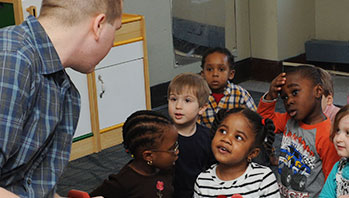- markers
- red objects
- color
- dark
- darkest
- light
- lightest
- red
- shade
MA Standards:
Speaking and Listening/SL.PK.MA.1: Participate in collaborative conversations with diverse partners during daily routines and play.
Language/L.PK.MA.1: Demonstrate use of oral language in informal everyday activities.
Language/L.PK.MA.6: Use words and phrases acquired through conversations, listening to books read aloud, activities, and play.
Language/L.PK.MA.5.a: Demonstrate understanding of concepts by sorting common objects into categories (e.g., sort objects by color, shape, or texture).
Head Start Outcomes:
Language Development/Receptive Language: Attends to language during conversations, songs, stories, or other learning experiences.
Language Development/Expressive Language: Uses language to express ideas and needs.
Language Development/Expressive Language: Uses increasingly complex and varied vocabulary.
PreK Learning Guidelines:
English Language Arts/Language 2: Participate actively in discussions, listen to the ideas of others, and ask and answer relevant questions.
Talk Together: Color Detective (red)

© Commonwealth of Massachusetts, Department of Early Education and Care (Jennifer Waddell photographer). All rights reserved.
STEM Key Concepts: There are many different colors; A color can have many different shades (from very light to very dark)
ELA Focus Skills: Color Recognition, Listening and Speaking, Vocabulary
Educator Prep: Before introducing the activity, place objects of different shades of red around the room.
Review the color green with children and ask, What green things did you find yesterday at home or on your way home?
Then tell children they will be learning about the color red today. Hold up a red crayon and say, This crayon is red. Look around the room. What else do you see that is red?
- Have each child find a red object and bring it back to the group. What red object did you find? Prompt children to respond in full sentences. (I found a red paper bag.)
- Put all the red objects together on the table. Encourage children to look closely at all the objects and ask, What object is the darkest shade of red? What object is the lightest shade? Do you think there are more light red objects in the pile or dark red objects? Why don't we put them in two groups to find our answer.
Adaptation: For groups with children of varying ages, you can give the younger children a sheet of red paper to help them identify red objects, and then pair younger children with older children to look for red objects.
